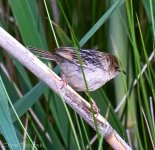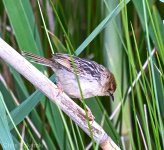-
Welcome to BirdForum, the internet's largest birding community with thousands of members from all over the world. The forums are dedicated to wild birds, birding, binoculars and equipment and all that goes with it.
Please register for an account to take part in the discussions in the forum, post your pictures in the gallery and more.
You are using an out of date browser. It may not display this or other websites correctly.
You should upgrade or use an alternative browser.
You should upgrade or use an alternative browser.
Wakkerstroom area South Africa Oct 22 (2 Viewers)
- Thread starter 49bentley
- Start date
More options
Who Replied?Surely that has a longer tail, clearer rufous headLooks like a Levaillant cisticola
Bewick
Connoisseur of WTL

Immatures have shorter tails I believe, the red on the face and head seems to significant for cloud or wind-snapping I would have thought.Surely that has a longer tail, clearer rufous head
Edit- wing-snapping does seem like another good possibility however the tail length also seems wrong, from pictures the wing-snapping's tail seems too short in comparison with the cisticola in op's pic.
Last edited:
Just looking in the sasol app photos and it doesn't show extensive red as we see here for levaillants. It has a photo of a juvenile with even less rufous. Maybe ebird photos will prove me wrong, but I feel jizz is wrong for that species where even juvenile seems more elongateImmatures have shorter tails I believe, the red on the face and head seems to significant for cloud or wind-snapping I would have thought.
Edit- wind-snapping does seem like another good possibility however the tail length also seems wrong, from pictures the wind-snapping's tail seems too short in comparison with the cisticola in op's pic.

Not sure what you're deciding on here but I think this bird is a pretty clear Levaillant's. It's much too long-tailed for Wing-snapping or other short-tailed cisticolas. According to Chamberlain, their tail feathers should be shorter than the tertials. The tail feathers here are around 1.5x the length of the tertials, which is better for a long-tailed species. The extensive thick black streaks on the mantle and black centred greater coverts, as well as the fine streaking on the rump and rufous wing panel all point towards Levaillant's. Lots of pictures here:Just looking in the sasol app photos and it doesn't show extensive red as we see here for levaillants. It has a photo of a juvenile with even less rufous. Maybe ebird photos will prove me wrong, but I feel jizz is wrong for that species where even juvenile seems more elongate
Levaillant's Cisticola - Cisticola tinniens - Media Search - Macaulay Library and eBird
Explore millions of photos, audio recordings, and videos of birds and other animals; powered by Macaulay Library and eBird. The Macaulay Library collects, archives, and distributes wildlife media for research, education, and conservation.
Andy Adcock
Worst person on Birdforum

Is Grey-backed in range?
Bewick
Connoisseur of WTL

Does not seem so according to the Ebird map.Is Grey-backed in range?
Think that one's not so dark on the back judging by photos. Also don't remember it beingDoes not seem so according to the Ebird map.
Andy Adcock
Worst person on Birdforum

Assume ID is correct, it looks fine to me.Think that one's not so dark on the back judging by photos. Also don't remember it being

grey backed cisticola - Bing
Intelligent search from Bing makes it easier to quickly find what you’re looking for and rewards you.
You can see back is greyer, paler than the op picAssume ID is correct, it looks fine to me.

grey backed cisticola - Bing
Intelligent search from Bing makes it easier to quickly find what you’re looking for and rewards you.www.bing.com
Andy Adcock
Worst person on Birdforum

I'm leaning towards Levaillant's, bill colour and structure, very pale underparts, why does it have white feather edges on the back?You can see back is greyer, paler than the op pic
Bewick
Connoisseur of WTL

Agreed, cloud-snapping would have buff feather edges on the back- while op's bird has pale/white feather edges on the back.I'm leaning towards Levaillant's, bill colour and structure, very pale underparts, why does it have white feather edges on the back?

The proportions I gave from Chamberlain are averages. On the same page there's a table showing how variable in length cisticola tails can be, particularly in the longer tailed species such as Levaillant's. Wing-snapping is mentioned as the shortest tailed species, on average.I've looked at ebird photos now and agree it must be levaillants.
I'd note, though, that wing-snapping's tail can be longer than stated in this thread. Look at ebird headline photo 2, for example, where tail roughly = wing length
There's also the ebird comment that tail length is longer in the non-breeding season (presumably short now)The proportions I gave from Chamberlain are averages. On the same page there's a table showing how variable in length cisticola tails can be, particularly in the longer tailed species such as Levaillant's. Wing-snapping is mentioned as the shortest tailed species, on average.
Larry Sweetland
Formerly 'Larry Wheatland'
+1 for Levaillant's. Wailing might be worth considering if it's in the area, but my first thought was Levaillant's
Users who are viewing this thread
Total: 3 (members: 0, guests: 3)






